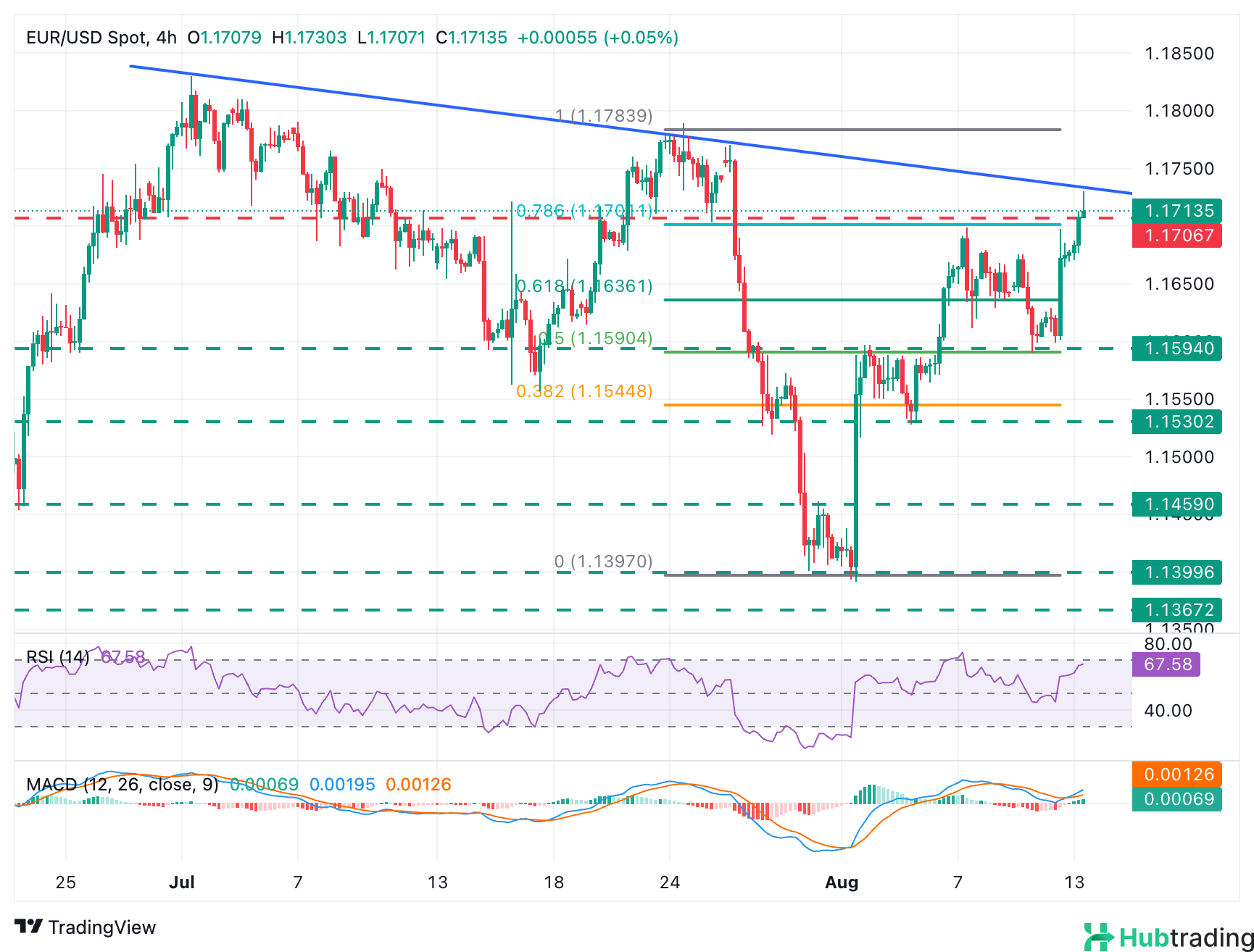-
The Euro strengthens as broad US Dollar weakness persists in the wake of softer US inflation data.
-
July’s CPI report has reinforced expectations of a Federal Reserve rate cut in September.
-
EUR/USD maintains a bullish bias, edging closer to key trendline resistance near 1.1735.
EUR/USD continues to trade above the 1.1700 mark ahead of Wednesday’s U.S. session, after reaching a fresh two-week high of 1.1730. The pair extended its rally for a second straight day, supported by softer U.S. Consumer Price Index (CPI) data and growing speculation of a Federal Reserve interest rate cut in September. However, gains have moderated as markets await speeches from Fed officials Austan Goolsbee and Raphael Bostic later in the day.
Tuesday’s CPI report showed consumer inflation holding steady in July, offering little evidence of upward pressure from recent tariff measures. Combined with signs of a cooling labor market, the data strengthened the case for the Fed to begin easing monetary policy next month.
At the same time, concerns are rising over potential political interference at the Fed, as President Trump is expected to nominate candidates who align with his push for looser monetary policy. These developments have heightened expectations of a more dovish policy stance, while also raising questions about the central bank's independence—further weighing on the U.S. Dollar.
With no major economic data on tap for the day, market sentiment will likely be driven by risk appetite and commentary from Fed officials. Traders will be closely watching remarks from Thomas Barkin, Austan Goolsbee, and Raphael Bostic for any signals confirming a rate cut in September. Overall, the balance of risks remains tilted against the U.S. Dollar.
Daily Market Movers: Risk Appetite Pressures the US Dollar, Eyes on Fed and EUR/USD Resistance
- The US Dollar weakened across the board on Tuesday as market sentiment turned risk-on following the release of softer-than-expected US inflation data. July’s Consumer Price Index (CPI) showed annual inflation steady at 2.7%, missing expectations of 2.8%, while core inflation ticked up to 3.1% from 2.9% in June. Despite the hotter core figure, the data reinforced hopes that the Federal Reserve has room to begin easing monetary policy to support growth and employment, particularly as the impact of tariffs on inflation remains limited.
- Markets welcomed the CPI report, with risk appetite rising and safe-haven demand for the US Dollar declining. According to the CME Group's FedWatch Tool, the probability of a 25 basis point rate cut in September climbed to 95%, up from 85% before the data release. Traders are also pricing in at least one more rate cut by October or December.
- Meanwhile, comments from Fed officials revealed a split in outlook. Thomas Barkin downplayed inflation concerns, suggesting support for rate cuts, while Jeffrey Schmid expressed caution, arguing that inflationary pressures are still too high to justify easing.
- In Europe, the final German Harmonized Index of Consumer Prices (HICP) confirmed a 0.4% monthly increase and 1.8% annual gain in July. However, the data had minimal impact on the Euro.
Technical Outlook: EUR/USD Tests Key Resistance at 1.1735

EUR/USD continues to exhibit bullish momentum, driven by US Dollar weakness and improving risk sentiment. The 4-hour Relative Strength Index (RSI) has rebounded above the 50 line, and the Moving Average Convergence Divergence (MACD) has crossed above its signal line—both pointing to continued upward pressure.
The pair has broken above the 78.6% Fibonacci retracement of the late-July decline at 1.1700 and is now challenging a critical descending trendline at 1.1735. This trendline has previously acted as resistance on July 1, 24, and 27. A clear break above this level would signal that the correction from the July 1 high has ended, opening the door to a retest of the July 24 peak at 1.1789.
However, if bulls fail to push through 1.1735, the pair could face downside support at the August 11 low of 1.1590. Further losses could expose the August 5 low near 1.1530 and the July 31 high around 1.1460.
In summary, the US Dollar faces growing headwinds amid increased Fed rate cut bets, while EUR/USD’s next directional move hinges on whether bulls can break through the 1.1735 resistance zone.





